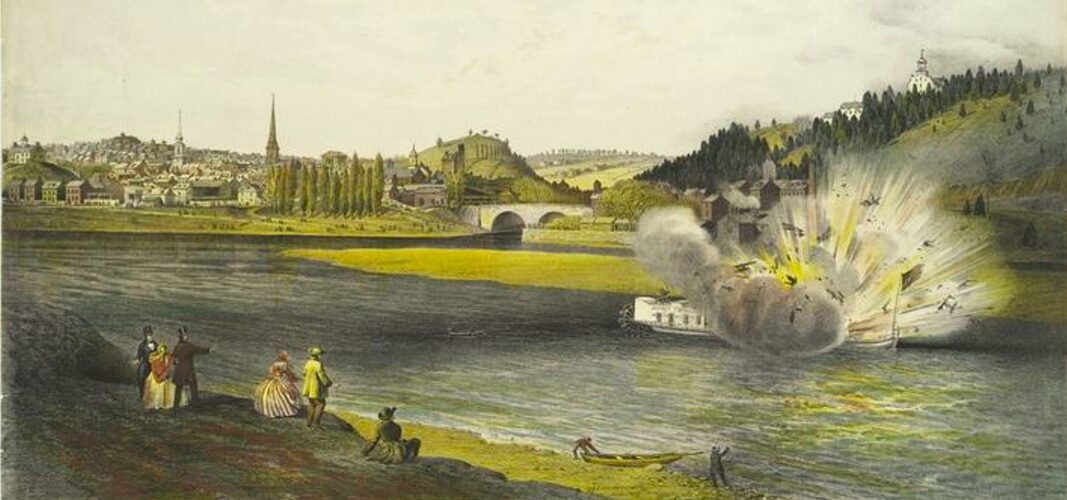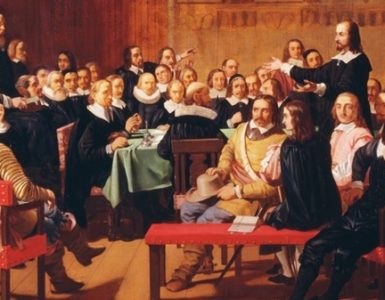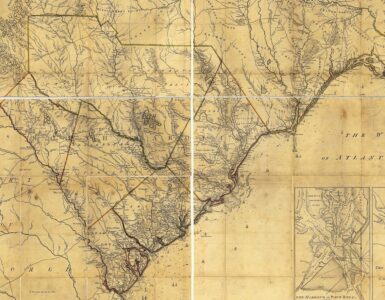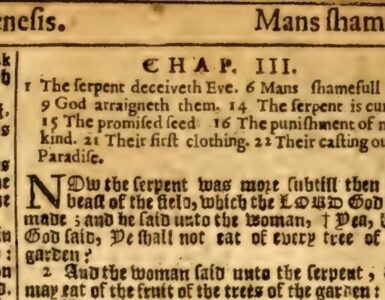 Two-hundred years ago this month William Henry was born January 27, 1825 to George Smith and Sarah (Kennedy) Green in Groveville, New Jersey. He became a communing member at the age of fifteen of the First Presbyterian Church in Easton, Pennsylvania. His preparatory studies were accomplished in Easton at the academy directed by Presbyterian minister Rev. John Vandeveer. Green graduated Lafayette College when he was but fifteen years old in 1840 but continued there for two years as a tutor. He then entered Princeton Seminary in 1842 to study for the ministry and completed the program in 1846. His seminary studies were postponed for a year because he served as an adjunct professor of mathematics at Lafayette College.
Two-hundred years ago this month William Henry was born January 27, 1825 to George Smith and Sarah (Kennedy) Green in Groveville, New Jersey. He became a communing member at the age of fifteen of the First Presbyterian Church in Easton, Pennsylvania. His preparatory studies were accomplished in Easton at the academy directed by Presbyterian minister Rev. John Vandeveer. Green graduated Lafayette College when he was but fifteen years old in 1840 but continued there for two years as a tutor. He then entered Princeton Seminary in 1842 to study for the ministry and completed the program in 1846. His seminary studies were postponed for a year because he served as an adjunct professor of mathematics at Lafayette College.
Green was licensed by the Presbytery of New Brunswick, February 3, 1846. During his two years as a licentiate he supplied pulpits and was an instructor in Hebrew at the seminary. Following ordination as an evangelist, he continued teaching Hebrew for one more year. During these three years he served both the Presbyterian churches in Princeton as stated supply, after which he was called to be the pastor of Central Presbyterian Church in Philadelphia. After serving Central Church for just two years his call was dissolved July 7, 1851, so he could beome the Chair of Biblical and Oriental Literature at Princeton Seminary. Dr. Green continued teaching for forty-nine years. As with many of the seminaries of the day, he served double duty because from 1851 to 1871 he was also the seminary librarian. For a number of years Dr. Green suffered from an incurable and debilitating disease that gradually weakened his constitution as time passed, but at times he would rally with a renewed vigor. However, on February 10, 1900, William Henry Green died at the age of seventy five.
The General Assembly of the PCUSA elected Green moderator for the sessions held in Detroit in 1891. It was a particularly challenging assembly because the massive and ornately decorated First Church was packed to overflowing because of issues regarding the teaching of C. A. Briggs of Union Seminary. Briggs’s professorship at Union correlated with Green’s at Princeton. Green’s leadership of the assembly was challenged further by the tragic death of Samuel M. Breckinridge after he collapsed on the podium having just completed reading a committee report. As was sometimes the case, Dr. Green’s illness so weakened him that in 1892 he was unable to attend the General Assembly in Portland to deliver his moderator’s sermon. However, he provided a copy that was read by Stated Clerk William H. Roberts to the assembly. The sermon was published in The Presbyterian Banner, May 25, 1891, and it is an exposition of Isaiah 45:15, “Verily thou art a God that hidest thyself, O God of Israel, the Saviour.”
On May 5, 1896, the fiftieth anniversary of Dr. Green’s appointment as an instructor in Princeton Seminary was celebrated with appropriate addresses in Alexander Hall on the campus of Princeton University. This commemoration occurred in conjunction with the annual seminary commencement and was attended by many distinguished representatives of other institutions. The proceedings were published in a volume that includes a complete bibliography of the numerous writings to come from Dr. Green’s pen. A brief statement was made at the anniversary meeting by Ethelbert D. Warfield as the representative of Green’s alma mater, Lafayette College. At the time, Ethelbert had been serving Lafayette as Professor of History and Political Science, a trustee, and its president for about five years. He would continue at Lafayette until 1914 and would see his brother, Benjamin Breckinridge Warfield, given the D. Litt. by Lafayette in 1911. In Ethelbert’s brief comments to Dr. Green and the gathering, he said—
It has been your peculiar privilege to occupy a position in which you have been able to render a great and notable service to the highest truth. In a day of prevalent apostasy, in a time when knowledge is exalted and wisdom is despised, you have embraced the opportunity, which so many have refused, to speak words of soberness and strength in defense of the Word of God. Your alma mater, mindful of all your faithfulness in many labors, congratulates you especially on the courage and modesty which have united to make so great a service possible.…God grant that you may long continue to open to successive classes the Word of God….
William Henry Green died February 10, 1900. He married Mary Elizabeth Colwell June 24, 1852, but she passed March 29, 1854. He was survived by his second wife, Elizabeth Hayes, whom he married on April 28, 1858, at Allegheny, Pennsylvania. Two daughters also survived who were both married to Princeton University Professors—one was married to William Libbey and the other to J. Mark Baldwin. W. H. Green was honored with the Doctor of Divinity by both Princeton University in 1857 and the University of Edinburgh in 1884, to which was added the LL.D. by Rutgers College in 1873. In 1868, he was elected to succeed President Maclean at Princeton University, which he declined, but he did serve the university as a trustee from 1868 until his death.
Dr. Green was a prolific writer and his subject matter was most often in his area of specialization, but he sometimes wrote on other subjects. His first piece for Biblical Repertory and Princeton Review (BRPR) was a review in 1850 of Keil’s commentary on Joshua. Most of his contributions to serials were printed in BRPR, but he also wrote for its successors Presbyterian Quarterly and Princeton Review, Presbyterian Review, and the Presbyterian and Reformed Review. From 1883 to 1892, he wrote the critical notes for the International Sunday School Lessons that appeared in The Sunday School Times published in Philadelphia. As the moderator of the General Assembly that was dealing with the Briggs Case, he handled the gavel having published in The Evangelist, July 23, 1885, “A Reply to Dr. Briggs on the Revised Version of the Old Testament,” and just before the assembly met, “Dr. Briggs’s Inaugural Address,” was printed in the New York Observer of April 16, 1891. Some of his books include Grammar of the Hebrew Language, 1861; The Pentateuch Vindicated from the Aspersions of Bishop Colenso, 1863; An Elementary Hebrew Grammar with Tables, Reading Exercises, and a Vocabulary, 1868, 1871; A Hebrew Chrestomathy, or, Lessons in Reading and Writing Hebrew, 1872; The Argument of the Book of Job Unfolded, 1874; The Hebrew Feasts, 1885; The Higher Criticism of the Pentateuch and The Unity of the Book of Genesis, both in 1895; and the two volumes, General Introduction to the Old Testament, The Canon, 1898, and General Introduction to the Old Testament, The Text, 1899. The later years of Green’s work often included defending, as with the Briggs case, the inspiration and supernatural origin of the Old Testament against the theories of higher criticism. His considerable collection of writings interpreting and defending the Bible have been neglected and a student today looking for a thesis or dissertation topic might consider Green’s work as an element of the foundation defending the Bible in the early years of the twentieth century. Log College Press has provided a collection of Green’s numerous works in PDF for free download at “William Henry Green(1825-1900).” It is quite a lengthy list.
Barry Waugh
Notes—The header is snipped from The Miriam and Ira D. Wallach Division of Art, Prints and Photographs: Print Collection, NYPL Digital Collections, “Explosion of the Alfred Thomas at Easton, Pennsylvania,” 1860; the domed building on a hill at the left edge appears to be on the Lafayette campus. The portrait of Dr. Green is from a CDV owned by the author of this biography. This biography relies heavily on the memorial for Dr. Green included in Necrological Reports and Proceedings of the Alumni Association of Princeton Theological Seminary, Vol. 3, 1900-1909, published in 1909, as found on pages 14-16. The bibliographic information for the book published with the proceedings of Dr. Green’s fiftieth anniversary celebration is, Celebration of the Fiftieth Anniversary of the Appointment of Professor William Henry Green as a Professor of Princeton Theological Seminary, May 5, 1896, New York: Charles Scribner’s Sons, 1896. Care should be used when speaking or writing of Alexander Hall in the village of Princeton because both the university and seminary have buildings with that name. At the seminary it is named for founding professor Archibald Alexander, but at the university, Alexander Hall was donated by Harriet Crocker Alexander in honor of her husband, Charles B., his father, Henry M., and Charles’s grandfather, Archibald Alexander, all of whom were trustees. So, in a way, both Alexander Halls were named for Archibald Alexander, D.D.





